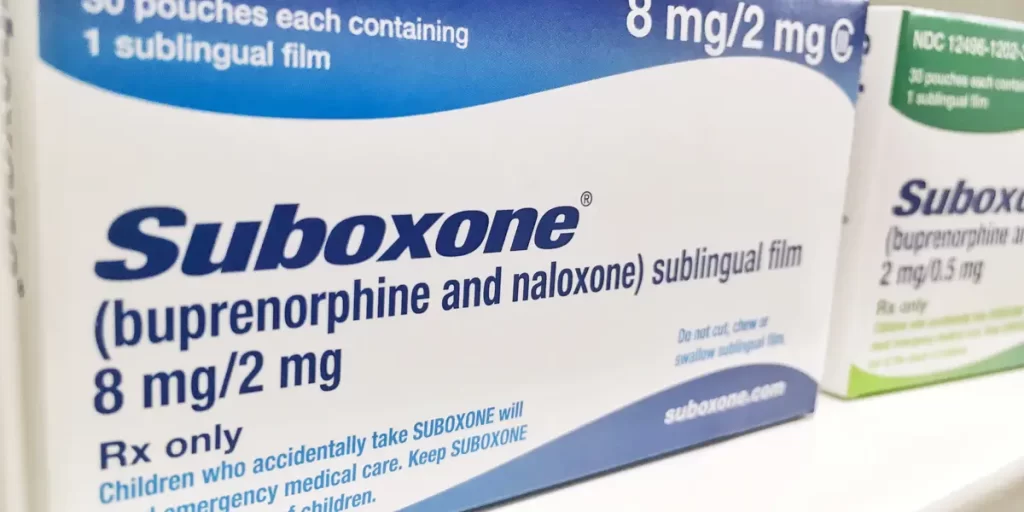Suboxone is the brand name for the combination of buprenorphine — an opioid medication — and naloxone. It’s commonly prescribed to treat opioid addiction in medication-assisted therapy (MAT) and is an alternative to methadone.
Although the medicine is meant to treat opioid addiction, it can be misused. It’s also not hard for patients to become addicted to Suboxone itself if they take more Suboxone than prescribed or more often than prescribed.

What Is Suboxone Used For?
Suboxone is FDA-approved for the treatment of opioid dependence. However, it can also be prescribed off-label for depression that has not responded to other treatments, and it is sometimes prescribed for pain.
How Does Suboxone Work?
Suboxone works by blocking other opioids from working. Further, it doesn’t produce a high like other opioids, which is why it is often used to treat opioid addiction.

It's time to get your life back.
If you are struggling with addiction and co-occurring mental health, our expert team is here to guide you every step of the way. Don’t wait— reach out today to take the first step toward taking control of your life.
The buprenorphine component of Suboxone only partially activates the mu-opioid receptors in your brain. This is in contrast to other opioids that fully activate the receptor, which can lead to a euphoric high. Because buprenorphine does not fully activate the receptor but binds to it regardless, it blocks the effects of any other opioids you may take to get high. It doesn’t give you a high, but still prevents opioid withdrawal symptoms.
The naloxone component of Suboxone is inert when the drug is taken by mouth. However, when the drug is abused and injected, naloxone will trigger opioid withdrawal by blocking any opioids from working at the mu-opioid receptor, including buprenorphine. Naloxone is included in Suboxone to dissuade people from abusing the drug by injecting it, as doing so would almost immediately trigger uncomfortable withdrawal symptoms.
How Long Does Suboxone Block Opiates?
Suboxone needs to be taken once daily to block opioid receptors in your brain effectively. To prevent withdrawal symptoms, Suboxone should be taken at the same time of the day every day.
How To Take Suboxone
Suboxone comes as a sublingual film. When you first start Suboxone, you should put the film under the tongue only. However, after a few days, you can make the choice to continue putting Suboxone under the tongue or try putting it on the inside of your cheek.
Regardless of how you choose to take Suboxone, it is important to take it whole and not cut, chew or swallow the film.
Suboxone Dosage
Suboxone comes in several different doses, depending on the amount of buprenorphine needed to prevent opioid withdrawal symptoms. The amount of naloxone also increases to make sure it would be enough naloxone to overcome any buprenorphine that was misused and injected. Available doses include:
- Buprenorphine 2 mg /naloxone 0.5 mg per film
- Buprenorphine 4 mg /naloxone 1 mg per film
- Buprenorphine 8 mg /naloxone 2 mg per film
- Buprenorphine 12 mg /naloxone 3 mg per film
Suboxone Film
The Suboxone brand is only available as a film. It comes as an orange rectangle with a white printed logo and is contained inside a child-resistant foil pouch for single use.
However, Suboxone is not the only buprenorphine product available as a film. Other products include Belbuca and Bunavail. However, only Bunavail also contains naloxone.
Suboxone Pill
Suboxone is not available as a pill. However, other buprenorphine products are, including Zubsolv, an orally disintegrating tablet that also contains naloxone.
Suboxone Injection
Because injectable naloxone prevents Suboxone from working, Suboxone is not available as an injection. However, there are other buprenorphine products that come as injections. These include Sublocade, a long-acting form of buprenorphine injected under the skin, as well as Probuphine, a buprenorphine implant.
Suboxone Skin Patch
Suboxone itself is not available as a skin patch; however, a long-acting buprenorphine skin patch exists. The medication is sold under the brand name Butrans.
Is Suboxone Addictive?
Like all opioids, Suboxone carries a risk of abuse, addiction and dependence. The drug is a Schedule III controlled substance, meaning it has a moderate abuse potential. This is in contrast to most other opioids that Suboxone is meant to replace, which have a higher abuse potential and addiction risk.
Although Suboxone can be addictive, most people who take Suboxone do not abuse it. A recent study showed that almost 75% of people who take Suboxone do not misuse the drug, and those that do misuse it are likely to take Suboxone not prescribed for them.
Suboxone Side Effects
Most people are able to take Suboxone without a problem. However, like all drugs, Suboxone has some side effects, including:
- Headache
- Anxiety
- Constipation
- Sweating
- Swelling in the legs and feet
- Slow urination
- Sleep disturbances
Can You Overdose on Suboxone?
It is possible to overdose on Suboxone just like any other opioid. The naloxone component of Suboxone prevents the drug from working if it is injected — however, an overdose by taking too much by mouth is still possible. For this reason, it is crucial to keep your Suboxone packets away from children and pets and never to take more Suboxone than prescribed to you.
Suboxone Withdrawal
Even though Suboxone is meant to treat symptoms of opioid withdrawal, it is still an opioid and can cause withdrawal symptoms on its own. When you take any opioid – including Suboxone – your body becomes used to its presence and adapts to having the drug in your system. For this reason, suddenly stopping it can trigger withdrawal symptoms.
Suboxone Withdrawal Symptoms
Suboxone withdrawal symptoms are similar to those of other opioids. These can include:
- Nausea or vomiting
- Anxiety
- Insomnia
- Hot and cold flashes
- Sweating
- Muscle cramps
- Watery eyes and nose
- Diarrhea
How Long Does Suboxone Withdrawal Last?
Because Suboxone is weaker than other opioids, Suboxone withdrawal is comparatively mild. Although short-acting opioids like Suboxone typically cause withdrawal symptoms within 8–24 hours that last for up to ten days, some data indicate that Suboxone withdrawal may take longer to occur.
How Long Does Suboxone Stay in Your System?
Suboxone keeps working in your body for an entire day, which is why it’s dosed on a daily basis.
However, the drug can be found in your system for a longer period of time depending on what is being tested:
- Urine: Buprenorphine itself can be found in your urine for up to seven days, and its breakdown products can be found in urine for up to 14 days.
- Blood: Traces of buprenorphine stay in your blood for up to 42 hours, and its breakdown products are detectable for up to 150 hours.
- Hair: A 1.5-inch hair sample can show if Suboxone was used in the past 90 days.
- Saliva: Suboxone can show up in saliva for up to two days.
Suboxone Detox Near Me
If you struggle with Suboxone, it is best to avoid quitting the drug cold turkey. This is especially true if you are taking Suboxone to treat an existing opioid dependency. The withdrawal symptoms can quickly become overwhelming and may increase your risk of relapse.
A medical detox center is the best and safest way to come off Suboxone. In medical detox, you get round-the-clock care from doctors and nurses to help safely treat your Suboxone addiction and prevent withdrawal symptoms. In our 16-bed detox facility outside Portland, Oregon, you can also receive treatment for co-occurring disorders like depression, as well as nutritional counseling.
Suboxone Rehab and Addiction Treatment
If you realize that you struggle with addiction and you choose to seek Suboxone treatment, you will need to find a national treatment facility like The Recovery Village Ridgefield. Before you can start your recovery journey, you’ll need to go through medically assisted detox first. You may need assistance from medical professionals with any withdrawal symptoms. Once you’ve completed detox, you’ll be recommended residential treatment, partial hospitalization or outpatient treatment, depending on your unique situation and needs.
Located close to the cities of Vancouver, Washington; Eugene, Oregon and Portland, Oregon, The Recovery Village Ridgefield is a national treatment center for alcohol and drug addiction treatment, including the treatment of Suboxone addiction. Contact us today and allow us to help you overcome your addiction.



